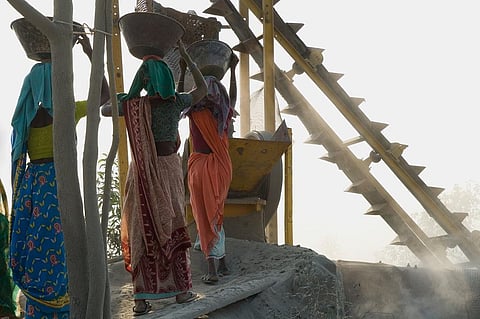Are manual labourers in India prepared for hot summers?
A recent World Bank report from November 2022 highlighted the impact of heatwaves on the Indian economy and population. More than 34 million people will be affected by job losses due to high heat by 2030 and more than 200 million people across the country will be exposed to hazardous heatwaves, the report stated.
These periods of abnormally high temperatures have become barriers to economic activities. They reduce one’s capacity to work during the hottest hours, especially affecting workers in outdoor occupations such as agriculture and manual labour.
Heat directly results in the loss of labour hours by preventing workers in professions demanding physical labour from operating safely due to excessive sweating, exhaustion and dehydration.
With nearly 90 per cent of the labour force engaged in the informal sector, mainly physically demanding labour, loss of working hours due to heat stress severely impacts the Indian economy.
The physical impact of heat on the workers is more concerning than the loss of hours. Daily intense physical work heightens the body heat.
Such changes to body temperature can alter bodily functions like digestion, assimilation and metabolism. Even jobs that do not require constant physical labour, like vending or running side stalls, become exhausting in acute weather.
Chanderpal, a mango seller, said:
What can I tell you about the experience other than that it’s just troublesome? We just persist through the heat. There is no other option. We stand beneath the tree shade for some relief and bathe four times a day.
Similarly, a tea stall owner said she felt particularly uncomfortable and exhausted on high-temperature days when she menstruated. Many construction workers have mentioned falling ill due to the heat but continuing to work to earn their livelihood.
Respite for the workers?
The World Bank report talked about a large section of the Indian population losing employment due to heat stress-related productivity issues. But it takes an overly capitalistic approach to try and address the issue.
The report heavily focuses on investment opportunities in India’s cooling sector, emphasising refrigeration and air conditioning to reduce food losses during transportation.
However, it fails to address the issues faced by the workers involved in occupations with high amounts of physical labour. Does the report focus more on the cure than the prevention? Yes.
With 90 per cent of India’s workforce being increasingly unsafe due to the rising temperatures, developing labour-centric interventions becomes crucial.
Heat Action Plans (HAP) can be an important step in addressing this problem. In 2016, the National Disaster Management Authority released national guidelines for heatwave management.
Under these guidelines, 17 heatwave-prone states and 120 districts and cities prepared HAPS. However, Ahmedabad was the only city to implement them successfully.
The HAP expanded access to shaded areas for outdoor workers. The Ahmedabad Municipal Corporation (AMC) ensured that night shelters remained open during the day to accommodate migrant workers during a heat alert.
They also urged labour organisations to consider extended afternoon breaks for workers or have alternate working hours. AMC’s labour and employment department also planned sensitisation workshops for employers, outdoor labourers and workers.
These workshops informed the attendees about the health impacts of extreme heat. Such labour-centric HAPs can be highly beneficial in urban centres where heatwaves occur regularly.
Nonetheless, a larger systematic change is needed since the informal sector does not fall under corporate law jurisdiction. The workers have no job security or social protection while their wages remain minimal, sometimes even below the legal minimum wage.
Revamping the informal sector will enable daily-wage workers to avail themselves of employee benefit schemes, contractual agreements and medical insurance coverage.
Contract-based employment protects labourers from being underpaid, thereby increasing their income and purchasing power. It protects workers from being overworked while providing paid sick leave.
Enhancing productivity, health and well-being of workers are vital to the Indian economy. Considering the current climate change trends, India will continue to face its share of heatwaves in the coming years.
Regulations and policy interventions that work towards the welfare of manual labour and workers exposed to heat stress must be administered nationwide, lest the productivity and the well-being of the labour force will continue to decline.
Also read:
Anirudh Krishnan is a research consultant with SPRF India.
Views expressed are the author’s own and don’t necessarily reflect those of Down To Earth.


